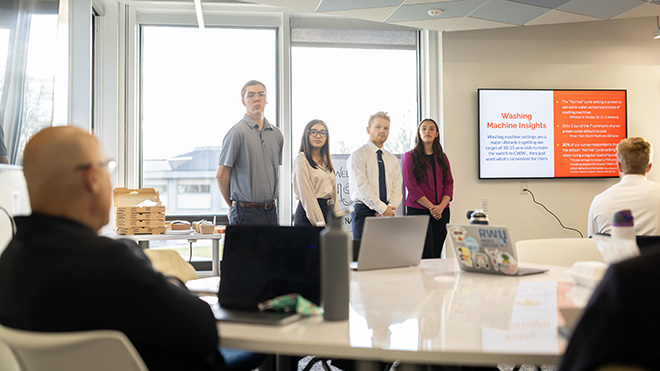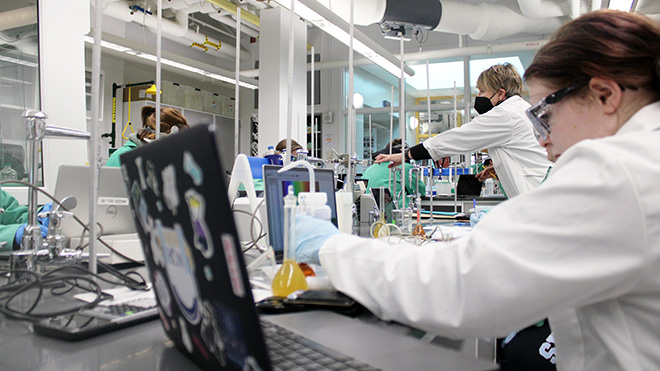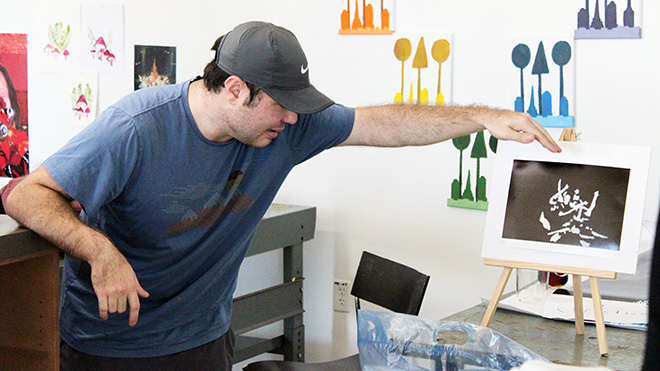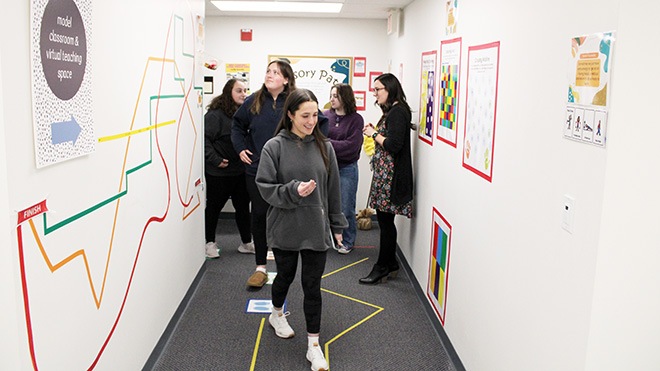RWU Invests in Dynamic, Renovated and Modernized Academic Spaces on Bristol Campus
With funding from the university, donor gifts, and federal earmarks, students from diverse academic disciplines will benefit from new classrooms, labs, and studio spaces.

BRISTOL, R.I. – A Data and Modeling Studio equipped with cutting-edge technology for Engineering, Computer Science, and Construction Management students. A Design Thinking Studio to inspire the next generation of marketers and advertisers. A Chemistry laboratory where students can use advanced testing instruments to assess aquatic ecosystem health.
These are a few of the spaces on Roger Williams University’s Bristol campus that were updated during the 2023-24 academic year to facilitate hands-on learning, innovation, entrepreneurship, and creativity among students of many academic disciplines. Investments from the university, federal earmarks, and a grant from the E. L. Wiegand Foundation have enabled the Academic Affairs and Capital Projects teams at RWU to redevelop and modernize existing teaching and research spaces as well as design new signature spaces.
“These renovated academic facilities across several schools and buildings have refreshed active learning spaces and created state-of-the-art research and collaborative labs that bolster student learning and academic success,” said RWU President Ioannis Miaoulis. “With student success and academic excellence at the center of our mission, RWU is committed to continuously investing in our campus facilities so that our learning resources match the quality of our high-caliber teaching and educational experience.”
In addition, a classroom master planning process has developed a list of prioritized upgrades to be made across every general-use classroom space on the Bristol campus over the next six years. The $7 million investment will go toward improving the quality, functionality and flexibility to create dynamic classroom spaces and make the best use of the technology enhancements that classrooms were outfitted with during the pandemic.
The changes are the result of multiple listening sessions and a survey with faculty about classroom use, teaching strategies, and desired changes to current RWU general use classrooms. Once spaces were identified for renovation, John Amitrano, Assistant Vice President for Facilities and Capital Projects, consulted with faculty who would use these rooms on the construction and schematic designs, including what equipment would be needed. The goal in updating the rooms is to make them more accessible and flexible for all students to use, he said. A new universal design will include adding movable furniture, height-adjustable desks, high-tech projectors, and more.
Here’s a look at some of the newly renovated academic spaces and how both students and faculty are making use of them.

SECCM Gets a New STEM-Focused Data and Modeling Studio
On the second floor of the School of Engineering building is the new E. L. Wiegand Data and Modeling Studio, a state-of-the-art space that allows existing programs in Engineering, Computer Science, and Construction Management to expand their quantitative teaching and research capacities. With generous funding from the E. L. Wiegand Foundation, the new space is designed to keep up with advancing technology that will prepare students for careers within and beyond STEM-related industries and be at the forefront of their fields.
The lab is outfitted with computers and large-screen monitors at students’ desks to provide them with ample space to work in multiple applications or with large data sets, as well as a newly installed camera and ceiling microphone that enables faculty to conference in presenters and experts from around the world, teach hybrid courses, or record their lectures, according to Karen Ethier, Senior Director of Support Services for Information Technology.
“I’m really appreciative of the Wiegand Foundation’s generosity,” said Robert Griffin, Dean of the School of Engineering, Computing, and Construction Management. “This is a big bonus for SECCM. The space is beautiful and really facilitates student learning.”
In addition to cutting-edge technology, the renovated classroom features a flexible layout that clusters students into small groups for collaboration, while six presenter displays on each wall allow students to watch the instructor’s display from any position in the room. Faculty can walk among students and provide feedback in an easier and more effective manner than a more traditional layout of rows of computers facing an instructor at the front of the room; this new design also facilitates better collaboration for group projects. Given the increased flexibility, the new lab space will help students learn softer skills vital to all industries, such as communication and teamwork, Griffin said.
Two satellite rooms adjacent to the E. L. Wiegand Data and Modeling Studio will soon be outfitted with virtual reality headsets for course-based lessons. And nearby break-out rooms also provide space for student collaboration with a large display and whiteboards for brainstorming and discussion.

Gabelli School’s New Design Thinking Studio Becomes Signature Learning Space
The E. L. Wiegand Design Thinking Studio, generously funded by the E. L. Wiegand Foundation, features a highly equipped and flexible space serving as a firsthand classroom, production studio, and team project workshop on the second floor of the Mario J. Gabelli School of Business.
What the E. L. Wiegand Center for Advanced Financial Education is to the Finance program, this new active learning space will be to RWU’s Marketing program, providing everything students need to collaborate on the Association for Information Systems (AIS) Student Chapter Leadership Conference and the National Student Advertising Competition (NSAC), as well as plan and produce content and campaigns for community-engaged courses.
In the main space, students can rearrange flexible furniture to work in groups, brainstorm on whiteboards, and share presentations on displays around the room. A content production studio is ready to support student projects with capacity for filming, sound recording, and photography, including backdrops, microphones, tripods, and lighting. A third conference room acts as a space to hold smaller group meetings and practice presentations on a TV display.
Geraldo Matos, Associate Professor of Marketing and faculty advisor for RWU’s chapter of the American Advertising Federation, said he is using the studio space as a classroom for his NSAC students. Outside of class, his students gather in the space to hold group meetings and conduct focus groups and one-on-one interviews, he said, noting that it allows for organic conversations to take place between students, which fuel their work.
“It gives the students a place to call home,” Matos said. “They love it.”
In addition to serving as a hub for NSAC students to engage in entrepreneurship and innovation, Matos said other professors can hold classes, and student clubs such as the Analytics Club can meet in the room.

Federal Funding and Gagliardi Family Support a State-of-the-Art Chemistry Lab
The Marine and Natural Sciences building recently unveiled a newly renovated Chemistry lab and a host of state-of-the-art equipment made possible as part of $1.6 million in federal funding secured by U.S. Senators Jack Reed and Sheldon Whitehouse in 2022. This visionary investment aims to establish a cutting-edge chemistry teaching and research laboratory specifically dedicated to providing opportunities for introductory and advanced Chemistry students to gain experience with world-class analytical equipment and apply them to assess aquatic ecosystem health.
In addition, the Gagliardi family has provided a generous donation that will support the maintenance and future physical upgrades of the laboratory, ensuring students will continue to have a world-class research space for years to come. The facility has been named The Gagliardi Laboratory for Research in the Chemical Sciences in their honor.
The Gagliardi Laboratory for Research in the Chemical Sciences is poised to become a hub for fostering innovation and collaboration among students and faculty. Professor of Chemistry Stephen O’Shea says that this overhaul paired with the acquired equipment — which includes a liquid chromatography–mass spectrometer, Raman spectrometer, fluorometer, UV-Vis spectrophotometer, and infrared spectrophotometer — represents a significant leap forward in the university’s scientific capabilities.
“The most exciting part of this newly renovated laboratory is that it provides our undergraduate students with hands-on experiences using leading-edge analytical equipment,” said Benjamin Greenstein, Dean of the Feinstein School of Social and Natural Sciences. “The technical skills they acquire will provide them with a head start in pharmaceutical, industrial or academic careers."
The redesigned space is set to improve student learning by accommodating up to 16 students, thereby maintaining small class sizes, and allowing students to see instruments in action and work on them directly, rather than just observing from afar.
Professors are equally enthusiastic about the upgrades, citing improved lighting, increased workspace, and enhanced ergonomics. O’Shea noted that renovating the Chemistry lab and moving classes to different spaces has freed up dedicated areas for faculty to have their own full-time bench space to conduct research.

Visual Arts Studio Provides Creative Work Space on Campus
The former Dunkin’ Donuts location in North Campus Residence Hall has been repurposed into a vibrant 500-square-foot Visual Arts space, creating a permanent home on the Bristol campus for students’ creative pursuits.
The transformation’s impact is palpable, especially for Visual Arts students who previously moved from classroom to classroom and had to put their large-scale projects on hold, said Professor of Art Elizabeth Duffy.
This dedicated studio allows students to keep their artwork in place, allowing them to develop their pieces over time and create on a larger scale.
"Part of working in a studio is hanging your work on the wall and coming back the next day, looking at it, and building off of it. That’s a necessary part of any artmaking,” Duffy said. “To have this space is really terrific. It’s going to be a game changer, no question about it.”
For Duffy, the studio will play a pivotal role in preparing upper-level students for successful careers in the art world by serving as a training ground for RWU's emerging talents to acquire the skills and confidence needed to navigate the challenging landscape of galleries, museums, and beyond.

Model Classroom and Sensory Path Create Innovative Education Training Opportunities
Seeking to revolutionize the way students prepare for teaching careers, the Education program has created a pioneering model classroom and sensory path located in the Education Department, on the ground floor of the School of Law building.
The model classroom, conceived in 2020 for virtual teaching simulations, has since evolved into a dynamic arena for hands-on experience, undergoing an expansion in 2022 to build a larger, more collaborative environment. Led by Kimberlee Johnsen-Smith, Director of Strategic Partnerships, Clinical Experiences, and Compliance in the Education Department, the room serves as a training ground for aspiring educators to conduct lesson planning, run small groups, and interact with peers in simulated teaching scenarios.
“It’s already had an incredible impact,” Johnsen-Smith said. “We're offering something that's unique across Rhode Island and among all the other amazing qualities that Roger brings.”
Complementing the model classroom is a sensory path, strategically located in the hallway just outside. Conceptualized and implemented by Jennie Diercksen, Coordinator of Field Experiences and Partnership Liaison for the Education Department, the sensory path embraces a universal design approach to benefit all learners, with each section designed to stimulate different sensory experiences, creating deeper pathways in the brain to support learning in diverse ways.
Looking Ahead to the Next Investments in Our Campus
While all of these updates, renovations and new construction have happened over the past year, there are still other projects on the horizon. Here is a sneak peek at two major projects that are currently in the planning process.
Environmental Engineering and Science Lab
With a $1.69 million federal earmark secured by U.S. Senator Jack Reed, RWU will acquire instrumentation to equip an Environmental Engineering and Science Lab that will support research and teaching to address the health and vitality of our surroundings, including the local coastal ecosystem and the Narragansett Bay watershed. The lab will be outfitted with cutting-edge analytical equipment to investigate environmental pollutants. Faculty and student researchers working in the new lab, which will be built inside the School of Engineering, Computing and Construction Management building, will collaborate on interdisciplinary teaching and research projects focused on soil, water, and air quality.
A New Campus Center Will Unite the University Community
Planning is underway to design a new Campus Center that will serve as a community hub in the heart of the Bristol campus. The new space, designed to enhance the student experience, will include Student Programs, Admissions, and other key student services as well as various multi-purpose event and programming spaces. After meeting with students, faculty and staff across the RWU community hearing hopes and needs for the space, Architecture firm Perkins + Will’s Boston-based team has been creating design proposals. Some early designs have been shared with the university community.
As part of President Miaoulis’s vision for RWU’s continued growth, the university will continue to invest in our existing facilities and design new spaces to serve current and future needs.